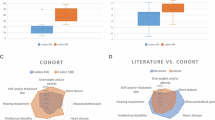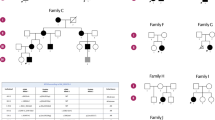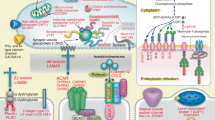Abstract
Myhre syndrome is characterized by short stature, brachydactyly, facial features, pseudomuscular hypertrophy, joint limitation and hearing loss. We identified SMAD4 mutations as the cause of Myhre syndrome. SMAD4 mutations have also been identified in laryngotracheal stenosis, arthropathy, prognathism and short stature syndrome (LAPS). This study aimed to review the features of Myhre and LAPS patients to define the clinical spectrum of SMAD4 mutations. We included 17 females and 15 males ranging in age from 8 to 48 years. Thirty were diagnosed with Myhre syndrome and two with LAPS. SMAD4 coding sequence was analyzed by Sanger sequencing. Clinical and radiological features were collected from a questionnaire completed by the referring physicians. All patients displayed a typical facial gestalt, thickened skin, joint limitation and muscular pseudohypertrophy. Growth retardation was common (68.7%) and was variable in severity (from −5.5 to −2 SD), as was mild-to-moderate intellectual deficiency (87.5%) with additional behavioral problems in 56.2% of the patients. Significant health concerns like obesity, arterial hypertension, bronchopulmonary insufficiency, laryngotracheal stenosis, pericarditis and early death occurred in four. Twenty-nine patients had a de novo heterozygous SMAD4 mutation, including both patients with LAPS. In 27 cases mutation affected Ile500 and in two cases Arg496. The three patients without SMAD4 mutations had typical findings of Myhre syndrome. Myhre–LAPS syndrome is a clinically homogenous condition with life threatening complications in the course of the disease. Our identification of SMAD4 mutations in 29/32 cases confirms that SMAD4 is the major gene responsible for Myhre syndrome.
Similar content being viewed by others
Log in or create a free account to read this content
Gain free access to this article, as well as selected content from this journal and more on nature.com
or
Accession codes
References
Myhre SA, Ruvalcaba RH, Graham CB : A new growth deficiency syndrome. Clin Genet 1981; 20: 1–5.
Becerra-Solano LE, Diaz-Rodriguez M, Nastasi-Catanese JA et al: The fifth female patient with Myhre syndrome: further delineation. Clin Dysmorphol 2008; 17: 113–117.
Burglen L, Heron D, Moerman A et al: Myhre syndrome: new reports, review, and differential diagnosis. J Med Genet 2003; 40: 546–551.
Davalos NO, Garcia-Ortiz JE, Garcia-Cruz D, Feria-Velasco A, Sanchez-Corona J : Myhre syndrome: first female case. Clin Dysmorphol 2003; 12: 119–121.
Garcia-Cruz D, Figuera LE, Feria-Velazco A et al: The Myhre syndrome: report of two cases. Clin Genet 1993; 44: 203–207.
Lopez-Cardona MG, Garcia-Cruz D, Garcia-Ortiz JE et al: Second female case of Myhre syndrome. Clin Dysmorphol 2004; 13: 91–94.
McGowan R, Gulati R, McHenry P et al: Clinical features and respiratory complications in Myhre syndrome. Eur J Med Genet 2011; 54: e553–e559.
Rulli I, Ferrero GB, Belligni E, Delmonaco AG, Defilippi C, Silengo M : Myhre’s syndrome in a girl with normal intelligence. Am J Med Genet A 2005; 134A: 100–102.
Soljak MA, Aftimos S, Gluckman PD : A new syndrome of short stature, joint limitation and muscle hypertrophy. Clin Genet 1983; 23: 441–446.
Titomanlio L, Marzano MG, Rossi E et al: Case of Myhre syndrome with autism and peculiar skin histological findings. Am J Med Genet 2001; 103: 163–165.
van Steensel MA, Vreeburg M, Steijlen PM, de Die-Smulders C : Myhre syndrome in a female with previously undescribed symptoms: further delineation of the phenotype. Am J Med Genet A 2005; 139A: 127–130.
Whiteford ML, Doig WB, Raine PA, Hollman AS, Tolmie JL : A new case of Myhre syndrome. Clin Dysmorphol 2001; 10: 135–140.
Lindor NM, Kasperbauer JL, Hoffman AD, Parisi JE, Wang H, Warman M : Confirmation of existence of a new syndrome: LAPS syndrome. Am J Med Genet 2002; 109: 93–99.
Hopkin RJ, Cotton R, Langer LO, Saal HM : Progressive laryngotracheal stenosis with short stature and arthropathy. Am J Med Genet 1998; 80: 241–246.
Lindor NM : LAPS syndrome and Myhre syndrome: two disorders or one? Am J Med Genet A 2009; 149A: 798–799.
Le Goff C, Mahaut C, Abhyankar A et al: Mutations at a single codon in Mad homology 2 domain of SMAD4 cause Myhre syndrome. Nat Genet 2012; 44: 85–88.
Caputo V, Cianetti L, Niceta M et al: A restricted spectrum of mutations in the SMAD4 tumor-suppressor gene underlies Myhre syndrome. Am J Hum Genet 2012; 90: 161–169.
Lindor NM, Gunawardena SR, Thibodeau SN : Mutations of SMAD4 account for both LAPS and Myhre syndromes. Am J Med Genet A 2012; 158A: 1520–1521.
Rosser EM, Wilkinson AR, Hurst JA, McGaughran JM, Donnai D : Geleophysic dysplasia: a report of three affected boys – prenatal ultrasound does not detect recurrence. Am J Med Genet 1995; 58: 217–221.
Al Ageeli E, Mignot C, Afenjar A et al: Retinal involvement in two unrelated patients with Myhre syndrome. Eur J Med Genet 2012; 55: 541–547.
Attisano L, Lee-Hoeflich ST : The Smads. Genome Biol 2001; 2: REVIEWS3010.
Zhang J, Tan X, Li W et al: Smad4 is required for the normal organization of the cartilage growth plate. Dev Biol 2005; 284: 311–322.
Yang SM, Hou ZH, Yang G et al: Chondrocyte-specific Smad4 gene conditional knockout results in hearing loss and inner ear malformation in mice. Dev Dyn 2009; 238: 1897–1908.
Shi Y, Massague J : Mechanisms of TGF-beta signaling from cell membrane to the nucleus. Cell 2003; 113: 685–700.
Howe JR, Roth S, Ringold JC et al: Mutations in the SMAD4/DPC4 gene in juvenile polyposis. Science 1998; 280: 1086–1088.
Hahn SA, Schutte M, Hoque AT et al: DPC4, a candidate tumor suppressor gene at human chromosome 18q21.1. Science 1996; 271: 350–353.
Schutte M, Hruban RH, Hedrick L et al: DPC4 gene in various tumor types. Cancer Res 1996; 56: 2527–2530.
Goriely A, Wilkie AO : Paternal age effect mutations and selfish spermatogonial selection: causes and consequences for human disease. Am J Hum Genet 2012; 90: 175–200.
Acknowledgements
We thank Pr Brendan H Lee from the Department of Molecular and Human Genetics, Baylor College of Medicine; Howard Hughes from the Medical Institute, Houston, TX, USA; Dr Lewis B Holmes and Dr Patricia Blakely from the Massachusetts General Hospital; Meaghan Muir from the Brigham and Women’s Hospital; and Dr Nicola Brunetti-Pierri from the Telethon Institute of Genetics and Medicine, Naples, Italy. We also would like to thank all the patients and their families.
Author information
Authors and Affiliations
Corresponding author
Ethics declarations
Competing interests
The authors declare no conflict of interest.
Rights and permissions
About this article
Cite this article
Michot, C., Le Goff, C., Mahaut, C. et al. Myhre and LAPS syndromes: clinical and molecular review of 32 patients. Eur J Hum Genet 22, 1272–1277 (2014). https://doi.org/10.1038/ejhg.2013.288
Received:
Revised:
Accepted:
Published:
Issue date:
DOI: https://doi.org/10.1038/ejhg.2013.288
Keywords
This article is cited by
-
Natural history of Myhre syndrome
Orphanet Journal of Rare Diseases (2022)
-
Lack of resemblance between Myhre syndrome and other “segmental progeroid” syndromes warrants restraint in applying this classification
GeroScience (2021)
-
SMAD4 mutations and cross-talk between TGF-β/IFNγ signaling accelerate rates of DNA damage and cellular senescence, resulting in a segmental progeroid syndrome—the Myhre syndrome
GeroScience (2021)
-
A case of Myhre syndrome mimicking juvenile scleroderma
Pediatric Rheumatology (2020)
-
Autism Spectrum Disorder and Psychiatric Comorbidity in a Patient with Myhre Syndrome
Journal of Autism and Developmental Disorders (2019)



